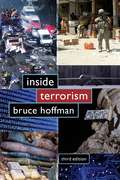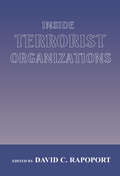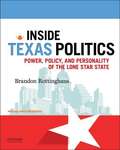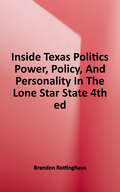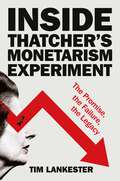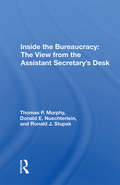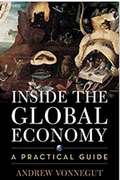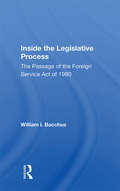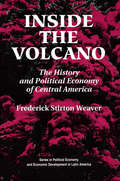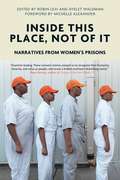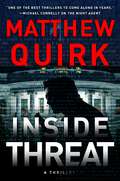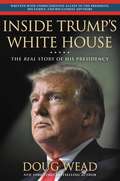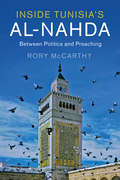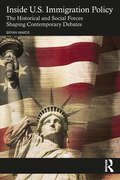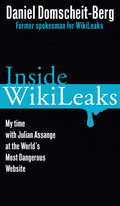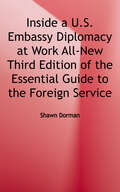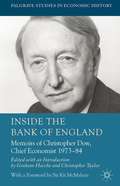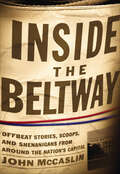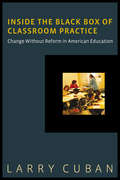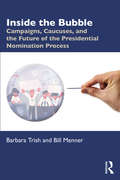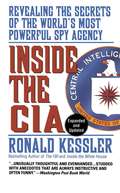- Table View
- List View
Inside Terrorism
by Bruce HoffmanBruce Hoffman describes the changing face of terrorism, probing the new adversaries, new motivations, and new methods that have surfaced in recent years to challenge many of our most fundamental assumptions about terrorists and how they operate. Hoffman dissects terrorism past and present, charting its evolution and predicting where it might be headed in the next century. Inside Terrorism traces the history of terrorism from its roots in the Reign of Terror that followed the French Revolution, to Communist movements in Russia, Germany, and Italy, to longstanding nationalist organizations such as the PLO, which emerged on the world stage after the massacre of Israeli athletes at the 1972 Olympic Games in Munich. Despite the ambush and murder of its own members, the PLO became a powerful and notorious terrorist group, and made the cause of a Palestinian homeland well known. Turning his attention to recent events, Hoffman argues that our notion of terrorism as a form of limited violence has been shattered by the emergence of more lethal and less predictable terrorist organizations, like the Aum sect in Japan -- responsible for the Tokyo subway nerve gas attack -- fanatical Jewish and Islamic groups in the Middle East, and radical wings of the militia movement in the United States. These fringe groups are built upon -- and react to -- a sense of isolation, and are more likely to use weapons of mass destruction than the nationalist terrorist groups with which we are familiar. Hoffman also considers the issue of media coverage and how it relates to political power. Although the media provide a platform for terrorist agendas, terrorists only occasionally achieve their ultimate political goals by exploiting the media, and are often captured as a result of news reports -- as in the Unabomber case. South Africa's African National Congress, which won sympathy for its plight and eventually obtained power in part through terrorist activities, is a rare exception to the rule. Carefully researched and filled with up-to-date information, Inside Terrorism presents a sharp and chilling portrait of a phenomenon that poses new and ever deadlier threats to peace and stability around the globe.
Inside Terrorism
by Bruce HoffmanBruce Hoffman's Inside Terrorism has remained a seminal work for understanding the historical evolution of terrorism and the terrorist mindset. In this revised edition of the classic text, Hoffman analyzes the new adversaries, motivations, and tactics of global terrorism that have emerged in recent years, focusing specifically on how al Qaeda has changed since 9/11; the reasons behind its resiliency, resonance, and longevity; and its successful use of the Internet and videotapes to build public support and gain new recruits. Hoffman broadens the discussion by evaluating the potential repercussions of the Iraqi insurgency, the use of suicide bombers, terrorist exploitation of new communications media, and the likelihood of a chemical, biological, radiological, or nuclear terrorist strike.Closer to home, Hoffman reconsiders the Timothy McVeigh case and the threats posed by American Christian white supremacists and abortion opponents as well as those posed by militant environmentalists and animal rights activists. He argues that the attacks on the World Trade Center fundamentally transformed the West's view of the terrorist threat. More relevant and necessary than ever, Inside Terrorism continues to be the definitive work on the history and future of global terrorism.
Inside Terrorism (Columbia Studies in Terrorism and Irregular Warfare)
by Bruce HoffmanBruce Hoffman's Inside Terrorism has remained a seminal work for understanding the historical evolution of terrorism and the terrorist mindset. In this revised edition of the classic text, Hoffman analyzes the new adversaries, motivations, and tactics of global terrorism that have emerged in recent years, focusing specifically on how al Qaeda has changed since 9/11; the reasons behind its resiliency, resonance, and longevity; and its successful use of the Internet and videotapes to build public support and gain new recruits. Hoffman broadens the discussion by evaluating the potential repercussions of the Iraqi insurgency, the use of suicide bombers, terrorist exploitation of new communications media, and the likelihood of a chemical, biological, radiological, or nuclear terrorist strike.Closer to home, Hoffman reconsiders the Timothy McVeigh case and the threats posed by American Christian white supremacists and abortion opponents as well as those posed by militant environmentalists and animal rights activists. He argues that the attacks on the World Trade Center fundamentally transformed the West's view of the terrorist threat. More relevant and necessary than ever, Inside Terrorism continues to be the definitive work on the history and future of global terrorism.
Inside Terrorism (Columbia Studies in Terrorism and Irregular Warfare)
by Bruce HoffmanBruce Hoffman's Inside Terrorism has remained the seminal work for understanding the historical evolution of terrorism and the terrorist mind-set. In this revised third edition of his classic text, Hoffman analyzes the latest developments in global terrorism, offering insight into new adversaries, motivations, strategies, and tactics. He focuses on the rise of ISIS and the resilience of al-Qaeda; terrorist exploitation of the Internet and embrace of social media; radicalization of foreign fighters; and potential future trends, including the repercussions of a post-caliphate ISIS.Hoffman examines the demographics of contemporary terrorist leaders and recruits; the continued use of suicide bombers; and the likelihood of a chemical, biological, radiological, or nuclear terrorist strike. He also considers the resurgence of violent antigovernment militants, including white supremacists and opponents of abortion. He argues that the war on terrorism did not end with Osama bin Laden's death and that ongoing instability and strife in Syria, Iraq, Afghanistan, Libya, and Yemen, among other places, will both sustain terrorist movements and have broad implications for domestic and international security around the globe.
Inside Terrorist Organizations
by David C. RapoportThese original essays describe the internal life of terrorist organizations in fascinating detail. They show how no description of terrorist behaviour is adequate without a grasp of the deep tensions that often characterize such groups, and an appreciation of how firmly implanted in our culture terrorist traditions have become, since the middle of the nineteenth century.
Inside Texas Politics: Power, Policy, And Personality Of The Lone Star State
by Brandon RottinghausInside Texas Politics provides students with an exciting insider's perspective on the world of Texas government. Its focus on how power struggles have shaped Texas institutions and political processes offers students a fresh perspective that differentiates itself from all other texts on the market. Rottinghaus' anecdotes make Inside Texas Politics fun and relevant for today's students, and his visual representations of data foster the skills students need in order to understand and think critically about the political world around them.
Inside Texas Politics: Power, Policy, and Personality of the Lone Star State
by Brandon RottinghausAccessible and memorable for today's students, this book presents the Texas government through an "insider's perspective" using engaging stories, contemporary news events, and current scholarship to help students understand and analyze politics in the great state of Texas.
Inside Thatcher’s Monetarism Experiment: The Promise, the Failure, the Legacy
by Tim LankesterIn 1979, Margaret Thatcher’s new government was faced with rampant double-digit inflation, rising unemployment and flatlining economic growth. In response, Mrs Thatcher pursued an economic policy which rejected the old orthodoxies and was promoted by only a minority of economists: a policy based on the doctrine of monetarism. This deeply damaging experiment in economic policy making promised much but completely failed to deliver. Tim Lankester was the private secretary for economic affairs to Mrs Thatcher during the early years of her government. His insider’s account explains her attitudes and decisions and those of the other main players. Offering fascinating insights into one of the most unsuccessful episodes of British economic history, he also relates its long-lasting impact and influence on society and the economy to this day, including present-day responses to tackling inflation.
Inside The Bureaucracy: The View From The Assistant Secretary's Desk
by Thomas P. MurphyIn recent years the enhanced role of political executives in the White House has tended to overshadow the contributions of assistant secretaries and other political executives in the Cabinet and other agencies. However, President Carter's determination to reestablish the primacy of the Cabinet has opened up the possibility that the assistant secretary's role will be reinvigorated. Assistant secretary positions, originally established for the direction of presidential programs, have evolved over time to encompass many additional roles. This is the first substantial analysis in more than a decade of the assistant secretaries' roles, relationships, and career patterns—as well as those of other presidential appointees. Based on the specific experiences of twenty-one assistant secretaries and three under secretaries who served during the Nixon, Ford, and Carter administrations, it provides invaluable insights into the background against which political executives carry out the president's programs and help formulate his policies.
Inside The Global Economy: A Practical Guide
by Andrew VonnegutThis comprehensive and informed text offers a practical introduction to the workings of the global economy. Drawing on his hands-on experience in international finance and economic policy, Andrew Vonnegut clearly explains economic concepts and illustrates them with cogent case studies. He describes the global economy by combining principles of economics with investment finance, decision theory, economic history, behavioral psychology, and accounting. Within a rigorous framework that sheds light on the reasons behind international economic events and trends, he brings the people, institutions, incentives, and money flows of the global economy to life. Oriented toward professionals and students, working or intending to work in the global economy, this book fills an important void. It will be invaluable for practitioners in business, investment finance, public policy, consulting, global studies, and journalism. Providing the tools needed to understand international economics, Vonnegut enlightens readers on the people, behaviors, and institutions behind trade and investment flows in today’s globalized economies, and how they all contribute to the volatile and dynamic world we are experiencing. ANCILLARIES ·Powerpoint slides for each class session ·Testbank that includes quizzes, a midterm, supplemental readings, and a final project ·Moodle site offering a complete online version of the course, including a syllabus
Inside The Legislative Process: The Passage Of The Foreign Service Act Of 1980
by William I. BacchusBeyond the popular notion that Congress is always engaged in high-level national policymaking and classic drama lies an important reality: the bulk of congressional activity is the protracted, grinding work of developing and enacting complex, detailed legislation vital to our nation's operation but often ignored by the public. This book illuminates the inner workings of legislative and executive interaction by focusing on one example of "low profile" legislation--the Foreign Service Act of 1980. Bacchus traces the making of this extremely complex law through its nine months of development in the Department of State and a further sixteen months in Congress from introduction to enactment. The act promises to be a key element of the U.S. foreign policy apparatus and of major importance in providing a sound basis for future operations of the Foreign Service; yet, the biggest danger its proponents faced was not opposition, but rather inattention and lack of interest. Beyond providing an accurate picture of the workings of Congress, Bacchus points to the risks to the public interest that are encountered when important legislation is enacted almost in private, influenced only by those who have direct stakes in the outcome.
Inside The Volcano: The History And Political Economy Of Central America
by Frederick Stirton WeaverCentral America sprang into the consciousness of the U.S. public in the late 1970s, propelled by the Nicaraguan revolution and the brutal civil wars in Guatemala and El Salvador. The continuing debates over the nature of the conflicts and the role of U.S. policy have too seldom acknowledged the historical depths of the crises' roots, and the size of the Central American nations has often led U.S. participants in the debate to underestimate the dynamism, complexity, and heterogeneity of the social structures that underlie the political struggles.This book presents a historical and analytical interpretation of recent Central American crises. Using a consistent comparative framework, Dr. Weaver sorts out the relations among economic growth, social organization, and political structure and offers explanations for the historically divergent developments among the five Central American nations. By setting those events in a broader Latin American context and illuminating the relationships between domestic and international influences, Dr. Weaver shows how rapid changes in the social organization of economic production in some periods affected social structures and configurations of political power, while at other times political conflicts conditioned and shaped subsequent patterns of economic expansion.
Inside This Place, Not of It: Narratives from Women's Prisons
by Ayelet Waldman Michelle Alexander Robin LeviInside This Place, Not of It reveals some of the most egregious human rights violations within women’s prisons in the United States. In their own words, the thirteen narrators in this book recount their lives leading up to incarceration and their experiences inside—ranging from forced sterilization and shackling during childbirth, to physical and sexual abuse by prison staff. Together, their testimonies illustrate the harrowing struggles for survival that women in prison must endure.
Inside Threat: A Novel
by Matthew Quirk"Quirk has earned his spot in the front ranks of thriller writers." — David BaldacciAn electrifying thriller from the author of The Night Agent now on Netflix, an attack on the White House sends the President and his top aides to take shelter in a top secret government facility buried deep underground—but they soon discover the threat is locked inside with them. Assume the worst. Code Black.The day that every secret service agent trains for has arrived. The White House has been breached; the President forced to flee to a massive doomsday bunker outside DC to defend against whatever comes next. Only the most trusted agents and officials are allowed in with him—those dedicated to keeping the government intact at all costs.Among these is Eric Hill, who has given his life to the Secret Service. They are his purpose and his family, and his impressive record has made him a hero among them. Despite his growing disillusionment from seeing Washington corruption up close, Eric can’t ignore years of instincts honed on the job. The government is under attack, and no one is better equipped to face down the threat than he is.The evidence leads him to a conspiracy at the highest levels of power, with the attack orchestrated by some of the very individuals now locked in with him. As the killers strike inside the bunker, it will take everything Eric Hill has to save his people, himself, and his country.Look for these other pulse-pounding thrillers by Matthew Quirk:Red WarningHour of the AssassinThe Night AgentDead Man Switch Cold Barrel Zero The Directive The 500
Inside Trump's White House: The Real Story of His Presidency
by Doug WeadAfter dozens of books and articles by anonymous sources, here is finally a history of the Trump White House with the President and his staff talking openly, on the record.In Inside Trump's White House, Doug Wead offers a sweeping, eloquent history of President Donald J. Trump's first years in office, covering everything from election night to the news of today. The book will include never-before-reported stories and scoops, including how President Trump turned around the American economy, how he "never complains and never explains," and how his actions sometimes lead to misunderstandings with the media and the public. It also includes exclusive interviews with the Trump family about the Mueller report, and narrates their reactions when the report was finally released.Contains Interviews with the President in the Oval Office, chief of staff, Mick Mulvaney, Jared and Ivanka Kushner, Donald Trump, Jr., Eric and Lara Trump, and White House insiders.
Inside Tunisia's al-Nahda: Between Politics and Preaching (Cambridge Middle East Studies #53)
by Rory McCarthyIn the wake of the Arab uprisings, al-Nahda voted to transform itself into a political party that would for the first time withdraw from a preaching project built around religious, social, and cultural activism. This turn to the political was not a Tunisian exception but reflects an urgent debate within Islamist movements as they struggle to adjust to a rapidly changing political environment. This book re-orientates how we think about Islamist movements. Drawing on extensive fieldwork with grassroots activists of Tunisia's al-Nahda, Rory McCarthy focuses on the lived experience of activism to offer a challenging new perspective on one of the Middle East's most successful Islamist projects. Original evidence explains how al-Nahda survived two decades of brutal repression in prison and in social exclusion, and reveals what price the movement paid for a new strategy of pragmatism and reform during the Tunisian transition away from authoritarianism.
Inside U.S. Immigration Policy: The Historical and Social Forces Shaping Contemporary Debates
by Bryan WardeInside U.S. Immigration Policy provides a comprehensive introduction to the development of U.S. immigration and immigration policies from the nation's colonial beginnings to the present day.Written for students of social welfare, social work, public policy, sociology, and history, the book develops a clear and historical framework for understanding current controversies around immigration. Bryan Warde offers a thoroughly researched account of immigration policies spanning 1882 to the present and calls upon theories and ideologies that explain conflicting views and shifting attitudes on immigrants and immigration. The book’s discussion is organized chronologically and each chapter supports students in developing the skills and knowledge to analyze and unpack the extent to which societal structures and values may oppress, marginalize, alienate, create, or enhance privilege and power in the context of immigration policies. It also reveals the forms and mechanisms of oppression and discrimination and leads readers to consider the sociopolitical factors that shape social policy and the provision of services to marginalized populations.Chapter summaries, timelines, and discussion questions throughout support learning and comprehension and encourage students to grasp the nuances and implications of this vastly important field of study. This book is an excellent addition to a range of undergraduate and graduate courses on social welfare, public policy, social work, sociology, and history.
Inside WikiLeaks
by Daniel Domscheit-BergFormer Wikileaks insider and spokesman Daniel Domscheit-Berg authors an expose of the "World's Most Dangerous Website." In an eye-opening account, Daniel Domscheit-Berg, the former spokesman of WikiLeaks, reveals never-disclosed details about the inner workings of the increasingly controversial organization that has struck fear into governments and business organizations worldwide, prompting the Pentagon to convene a 120-person task force. Under the pseudonym Daniel Schmitt, Domscheit-Berg was the effective Number 2 at Wikileaks and the organization's public face, after Julian Assange. In this book, he reveals the evolution, finances, and inner tensions of the whistleblower organization, beginning with this first meeting with Assange in December 2007. He also describes what led to his September 2010 withdrawal from WikiLeaks, including his disenchantment with the organization's lack of transparency, its abandonment of political neutrality, and Assange's increasing concentration of power.From the Hardcover edition.
Inside a U. S. Embassy: Diplomacy at Work, All-new Third Edition of the Essential Guide to the Foreign Service
by Shawn DormanInside a U.S. Embassy is widely recognized as the essential guide to the Foreign Service. This all-new third edition takes readers to more than fifty U.S. missions around the world, introducing Foreign Service professionals and providing detailed descriptions of their jobs and firsthand accounts of diplomacy in action. In addition to profiles of diplomats and specialists around the world--from the ambassador to the consular officer, the public diplomacy officer to the security specialist--is a selection from more than twenty countries of day-in-the-life accounts, each describing an actual day on the job. Personal reports from the field give a sense of the extraordinary challenges--the coups, the natural disasters, the civil wars--and rewards of representing America to the world. Inside a U.S. Embassy includes new chapters on the highly competitive Foreign Service entrance process, Foreign Service life outside the embassy, and briefings on topics such as handling high-level visits and service in war zones.
Inside the Bank of England
by Christopher Taylor Graham HaccheA personal memoir from Christopher Dow, an influential British economist and a key player in the banking establishments of the post-war era. Contains insights and revelations into the issues and protagonists shaping British economic policy in the late 20th Century.
Inside the Beltway: Offbeat Stories, Scoops, and Shenanigans from around the Nation's Capital
by John MccaslinFor more than a decade, John McCaslin has covered the Beltway beat for the Washington Times, in his extremely popular, widely quoted, award-winning column. Now, in his new book, McCaslin explores a vast array of little-known political tidbits, using humor, touching stories, and exclusive inside details to show readers exactly how the political game is played, revealing the humanity (for better or worse) of today's biggest politicos. With his characteristic blend of humor and warmth, McCaslin relates exclusive stories that will make readers laugh, leave them outraged, and touch their hearts about politicians on both sides of party lines and both ends of Pennsylvania Avenue.
Inside the Black Box of Classroom Practice: Change Without Reform in American Education
by Larry Cuban2015 Outstanding Book Award, Association for Educational Communications & Technology (AECT) A book that explores the problematic connection between education policy and practice while pointing in the direction of a more fruitful relationship, Inside the Black Box of Classroom Practice is a provocative culminating statement from one of America&’s most insightful education scholars and leaders.Inside the Black Box of Classroom Practice takes as its starting point a strikingly blunt question: &“With so many major structural changes in U.S. public schools over the past century, why have classroom practices been largely stable, with a modest blending of new and old teaching practices, leaving contemporary classroom lessons familiar to earlier generations of school-goers?&” It is a question that ought to be of paramount interest to all who are interested in school reform in the United States. It is also a question that comes naturally to Larry Cuban, whose much-admired books have focused on various aspects of school reform—their promises, wrong turns, partial successes, and troubling failures. In this book, he returns to this territory, but trains his focus on the still baffling fact that policy reforms—no matter how ambitious or determined—have generally had little effect on classroom conduct and practice. Cuban explores this problem from a variety of angles. Several chapters look at how teachers, in responding to major policy initiatives, persistently adopt changes and alter particular routine practices while leaving dominant ways of teaching largely undisturbed. Other chapters contrast recent changes in clinical medical practice with those in classroom teaching, comparing the practical effects of varying medical and education policies. The book&’s concluding chapter distills important insights from these various explorations, taking us inside the &“black box&” of the book&’s title: those workings that have repeatedly transformed dramatic policy initiatives into familiar—and largely unchanged—classroom practices.
Inside the Black Box of Classroom Practice: Change without Reform in American Education
by Larry CubanA book that explores the problematic connection between education policy and practice while pointing in the direction of a more fruitful relationship, Inside the Black Box of Classroom Practice is a provocative culminating statement from one of America's most insightful education scholars and leaders.Inside the Black Box of Classroom Practice takes as its starting point a strikingly blunt question: "With so many major structural changes in U.S. public schools over the past century, why have classroom practices been largely stable, with a modest blending of new and old teaching practices, leaving contemporary classroom lessons familiar to earlier generations of school-goers?" It is a question that ought to be of paramount interest to all who are interested in school reform in the United States. It is also a question that comes naturally to Larry Cuban, whose much-admired books have focused on various aspects of school reform--their promises, wrong turns, partial successes, and troubling failures. In this book, he returns to this territory, but trains his focus on the still baffling fact that policy reforms--no matter how ambitious or determined--have generally had little effect on classroom conduct and practice. Cuban explores this problem from a variety of angles. Several chapters look at how teachers, in responding to major policy initiatives, persistently adopt changes and alter particular routine practices while leaving dominant ways of teaching largely undisturbed. Other chapters contrast recent changes in clinical medical practice with those in classroom teaching, comparing the practical effects of varying medical and education policies. The book's concluding chapter distills important insights from these various explorations, taking us inside the "black box" of the book's title: those workings that have repeatedly transformed dramatic policy initiatives into familiar--and largely unchanged--classroom practices.
Inside the Bubble: Campaigns, Caucuses, and the Future of the Presidential Nomination Process
by Barbara Trish William J MennerInside the Bubble: Campaigns, Caucuses, and the Future of the Presidential Nomination Process is a behind-the-scenes look at the 2020 Democratic nomination process focusing on the Iowa caucuses and the campaign workers who located there. For decades, Iowa held the first contest in the presidential nomination process and individuals interested in campaign work considered it a "holy grail." But in 2020, a record number of Democrats seeking to unseat President Trump – and the hundreds of young campaign workers who located to Iowa – created a political event unmatched in scope and scale. Those workers, embedded in the caucus bubble, focused for months on finding supporters for their candidate and ensuring they attended their precinct event – the first step in selecting delegates to the national convention. And then Caucus Day came, and with it a technology-driven fiasco that seemed to foreshadow a year of pandemic and protest. The lessons learned in 2020 underscored the importance of local staff who organize and mobilize supporters for a candidate in whom they believe. And those lessons are applicable to any race of any party in any state. For students of US politics as well as aspiring candidates, political journalists, and campaign professionals, this book captures the drama and human perspective of campaigns and elections in America.
Inside the CIA: Revealing the Streets of the World's Most Powerful Spy Agency
by Ronald KesslerExamination of the CIA from the perspective of its prominent directors, veteran officers, and significant critics

